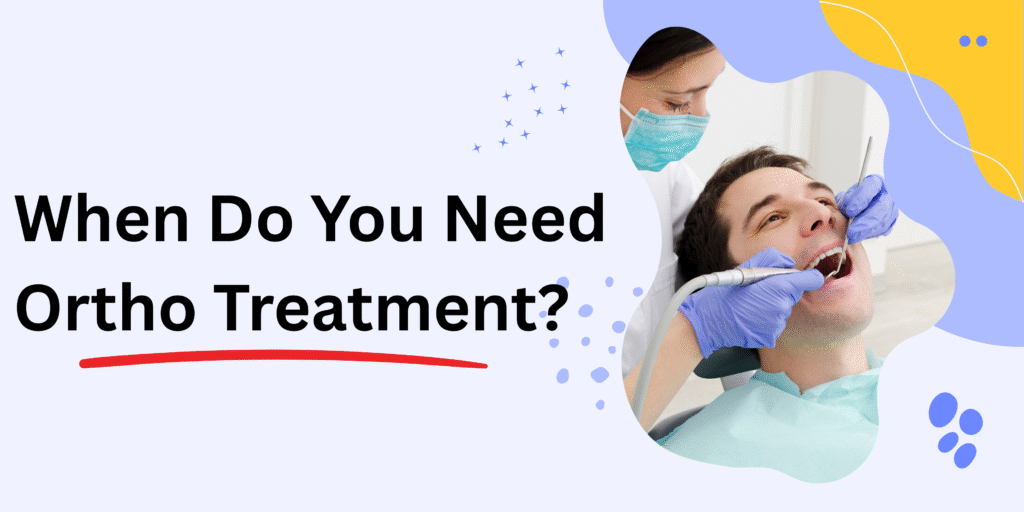A beautiful smile is more than just an aesthetic feature—it reflects your oral health and overall confidence. But sometimes, dental issues like crowded teeth, misaligned jaws, or abnormal bites can affect both function and appearance. This is where orthodontic (ortho) treatment comes into play. Orthodontic treatment helps correct the alignment of teeth and jaws, ensuring a healthier, more functional smile.
If you’ve ever wondered, “Do I really need braces or orthodontic care?”—here are the most common signs that you might benefit from seeing an orthodontist.
- Crowded Teeth
Crowding occurs when there isn’t enough room in your jaw for all your teeth to fit properly. As a result, the teeth overlap or twist out of position. Besides affecting your smile, crowded teeth make brushing and flossing difficult, which can lead to plaque buildup, tooth decay, and gum disease. Orthodontic treatment like braces or aligners can create the necessary space and align teeth in their correct positions.
- Spacing or Gaps
Some people experience noticeable gaps between teeth due to missing teeth, small teeth, or mismatched jaw size. While gaps might seem like just a cosmetic issue, they can actually cause improper bite patterns and even food lodgment, which increases the risk of gum problems. Closing these spaces through orthodontics enhances both appearance and functionality.
- Overbite
An overbite happens when the upper front teeth overlap the lower teeth excessively. While a slight overbite is natural, a severe one can cause tooth wear, jaw strain, and sometimes speech issues. Correcting an overbite not only improves your bite but also prevents potential damage to the enamel and gums.
- Underbite
In an underbite, the lower front teeth extend forward beyond the upper front teeth. This type of bite can affect chewing, speaking, and facial aesthetics. In severe cases, it may even cause jaw pain and uneven tooth wear. Orthodontic treatment can gradually bring the teeth and jaw into proper alignment.
- Crossbite
A crossbite occurs when some upper teeth sit inside the lower teeth when you bite down. This misalignment can lead to abnormal wear on the teeth, gum recession, and even facial asymmetry if left untreated. Braces, clear aligners, or expanders are commonly used to correct crossbites early.
- Open Bite
In an open bite, the upper and lower front teeth do not touch when the mouth is closed, leaving a visible gap. This can make biting into food challenging and may also cause speech difficulties, such as lisping. Orthodontic care helps close the gap so that teeth meet properly.
- Jaw Misalignment
If you experience frequent jaw pain, difficulty in chewing, or clicking sounds when opening your mouth, it could be due to a misaligned jaw. Such issues often stem from an improper bite and can lead to temporomandibular joint (TMJ) disorders. Orthodontists work on realigning teeth and jaws to restore normal function and comfort.
- Early or Late Loss of Baby Teeth
The timing of baby teeth loss plays a crucial role in how permanent teeth erupt. Losing baby teeth too early or too late may cause permanent teeth to grow in crooked or misaligned. For children, orthodontic evaluation at an early stage helps detect these issues and prevent more complex problems later.
- Protruding Teeth
Teeth that stick out noticeably not only affect appearance but are also at a higher risk of trauma or injury, especially during sports or accidental falls. Orthodontic treatment reduces this risk by aligning protruding teeth into a safer, more natural position.
- Difficulty in Maintaining Oral Hygiene
Crooked or crowded teeth make it harder to brush and floss properly. Food particles easily get trapped, leading to plaque buildup, tooth decay, and gum disease. By straightening teeth, orthodontic treatment makes oral hygiene more effective and reduces long-term dental risks.
Why Early Orthodontic Evaluation Matters
The American Association of Orthodontists recommends children get their first orthodontic evaluation by age seven. However, it’s never too late for adults to seek treatment. Whether you’re in your teens, twenties, or fifties, modern orthodontics—including clear aligners and less-visible braces—makes it easier than ever to correct dental issues discreetly.
Final Thoughts
Orthodontic treatment is not just about achieving a picture-perfect smile—it’s about improving your oral health, bite function, and overall quality of life. If you notice crowded teeth, gaps, misaligned jaws, or any of the conditions mentioned above, it’s a clear sign to consult an orthodontist.
The sooner you seek professional guidance, the easier it is to correct the issue and prevent long-term complications. A straight, healthy smile is always worth the investment.

